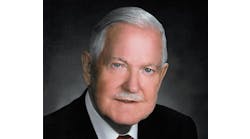“We learned that business models are as important as technical models, and we needed to accommodate these in our standard as well.” GM’s Jim Hall described his division’s global controls standardization effort at Automation Fair this week in Chicago.
The automotive sector has seen as much change as any industry in recent years. Global markets and digital transformations have affected automotive manufacturing in ways that are as disruptive as they are productive.
Individuals from two U.S.-based manufacturers, General Motors and Ford Motor Company, shared their thoughts on how technology has moved the industry forward during the Automotive & Tire Forum at Automation Fair 2019, Rockwell Automation’s annual user event this week in Chicago.
Jim Hall, Director, GPS-ME Assembly, Controls & Test, General Motors, and Scott King, Manager, Advanced Manufacturing IT, Ford Motor Company, described their organizations’ transformations for a standing-room-only crowd.
Global standardization at GM
“2018 brought the largest launch of engines and transmissions in GM history. It was done in conjunction with a major change in control specifications,” explained Hall. “We took the GM Common Control Standard, which had been used for decades in vehicle assembly, and built it into the global standard for powertrain applications in 2018.”
The Global Common Controls Standard specifies everything from processors to cords, explained Hall. “It’s very, very integrated,” he said. “It allows our organization to utilize engineering from shop to shop, and makes the skills of our people more portable. When a person walks up to a robot cell anywhere, that person can quickly understand an issue and begin solving problems. Another benefit is that safety systems and HMIs across the organization all look and feel the same.”
This change in standards had substantial effects on GM Global Propulsion Systems (GPS-ME), their OEMs and Rockwell Automation.
The OEM base spanned Germany, Sweden, France, the United States, Canada, Spain, Japan and Korea. “We needed to shift our organization to enable more technical capabilities,” explained Hall. “This took a couple forms. We engaged the technical capability of our people; we brought in new engineers and interns, and those people became key to our technical capabilities.”
The company learned that improvements and changes were needed to optimize the global common standard for engine and transmission applications, Hall said. Differences in pitch, integration, and layout meant that hardware configurations needed to be modified. “Importantly,” explained Hall, “we also learned that business models are as important as technical models, and we needed to accommodate these in our standard as well.”
“In the end the change was successful,” Hall concluded. “It was a huge job, but we all made it happen.”
Ford’s IIoT approach
The exponential growth of the Industrial Internet of Things (IIoT) is reshaping business and industry. New products are increasingly interconnected to the rest of the world and interfacing with one another.
The amount of data spilling from Ford’s systems is staggering. If a kilobyte of data were a gallon of water, it could fill Lake Michigan every 48 hours. That’s a quadrillion gallons of water every two days. That’s 15 zeroes, which is quite a large data lake.
In the past, Ford had not been able to get at all that data—to extract it, bring it forward and peer into operations. But to meet its goals, there are key capabilities it needs to enable, primarily to differentiate customer experiences.
Most remarkably, Ford manages seven digital twins: as designed, as supplied, as built, as operated, as well as of the manufacturing process, of the facility and the one the customer experiences.
The digital twins help Ford to understand how the product is changing and how it’s being used. The company sees that digital thread as one of its most important capabilities, and uses it to harness disruptive technologies across the value chain and impact products, processes and business models.
Disruptive technologies are enabling new capabilities across the value chain at Ford, creating new ways to engage stakeholders throughout the ecosystem and deliver customer experiences.
With 84 facilities worldwide, Ford uses equipment from a variety of sources, which could easily lead to fragmented solutions. Its first goal is to get the data up and off the plant floor into the platform and add context to it. A relentless focus on standardization allows its IIoT platform to enable the development of use cases by using a common, standardized platform, allowing it to speed development and quickly scale.
It strove to think big, start small and move fast. By establishing the foundation, then broadening the capabilities in the plant and finally scaling across the enterprise network, all 84 plants are on the docket to be linked and become part of Ford’s IIoT.
The editors of Control are on-site at Automation Fair 2019 to bring you breaking news, innovations and insights from the event. Once the event is over, they will put together a report featuring the top news. Pre-order your copy today.






